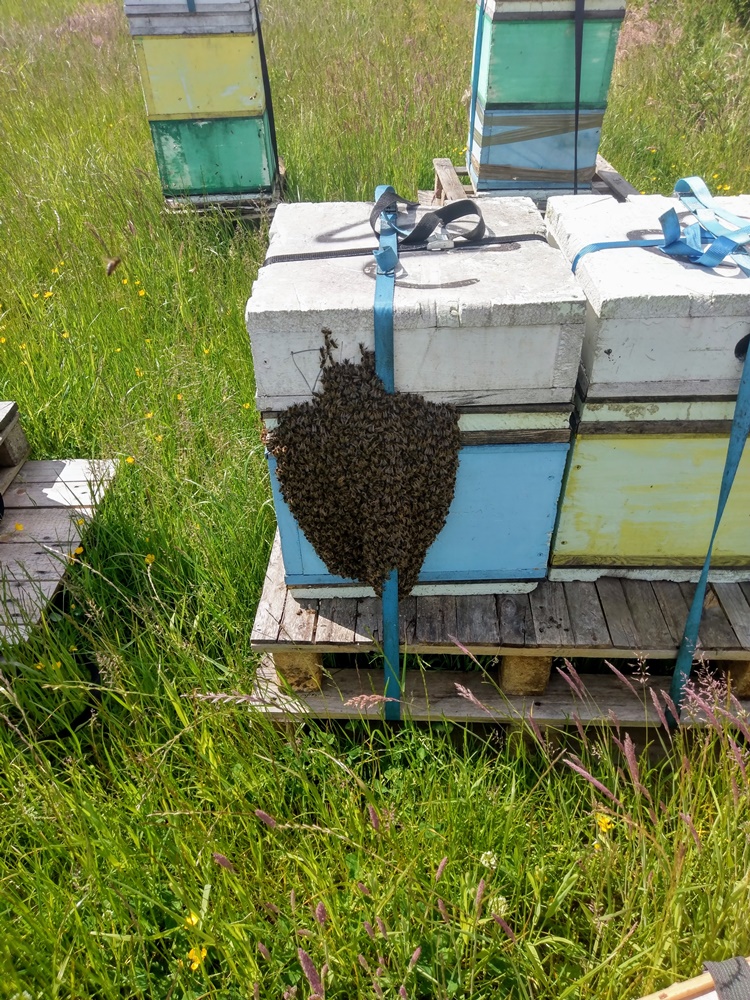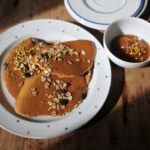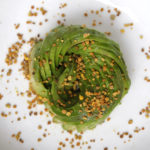WHAT IS A SWARM?
“Swarm” is not plural for many honeybees, like a “herd of buffalo” or a “school of fish,” it’s a term used to describe a grouping of honeybees that recently split-off from a strong “mother colony” to start a new hive. Catching and transferring swarms is our preferred method of populating hives.
Swarming is the natural method honeybee colonies use for reproduction. The original colony replaces the old queen, who leaves the hive with about half of the worker bees and as much honey as they can carry. Swarms land on a structure near their original hive location, cluster themselves, while scout bees leave in search of a new hive location. It’s in this stage that swarms can be captured and used to populate an empty hive. Swarms are immediately ready to start building comb within their new home.
Swarms are local to the areas they are found in. They are guaranteed to have survived the winter in that climate, and were strong enough to split in early spring. This method of obtaining bees aids in the goal of propagating strong genetics for local honeybee populations. We have had the greatest success with bees caught from swarms in our own apiary, and have found that swarms generally fare much better than bees shipped across the country in packages.
ARE SWARMS DANGEROUS?
Honeybees are at their most docile when swarming. At this stage, they do not have a hive with honey and brood to protect, and their honey-guts are full of honey stores from the original hive. Full bees are gentle bees, partly because it is physically difficult for them to tilt their abdomens enough to sting. It is almost like doing karate after Thanksgiving dinner. That said, bee behaviour is largely determined by genetics. Just like people, some colonies are simply nicer than others!
HOW DO I FIND A SWARM?
Swarm season generally occurs between spring and early summer. Being connected in the local beekeeping community greatly increases your chances of finding a swarm. Join local swarm lists like beeallies.com and lists associated with your local beekeeping clubs.
Give your contact information to your local fire department and pest control agencies. They often get calls for honeybee removal and would rather outsource the job to a local beekeeper than “dispose” of a swarm. Also, inform your friends and family that you are interested in catching swarms; before long, your phone may be ringing off the hook on a warm spring day! We find it helpful to keep our swarm catching gear in our trunks all spring long to be ready at a moment’s notice.
HOW DO I COLLECT A SWARM?
Once you have put out swarm-catching tendrils to your area and communities, it is beneficial to have your tools and equipment ready to go. Use the winter months to sort, clean, and ready your gear. You will discover what you are likely to need for spring, what needs replacing, and it gives you time to swap and share with other local beekeepers. Then ready your gear for the busy season. During swarm season, we can rarely be found without our toolkits in our vehicles!
Every swarm-catching toolkit should include:
1. Breathable box made of wood or cardboard (cardboard file boxes work great!)
2. Light colored bed sheet or tarp
3. Bee brush
4. Pruning shears
5. Lemongrass oil
6. Protective gear (swarm catching can be a great educational opportunity for the community about honeybees, so if you have it, bring extra gear for interested witnesses who would like to participate)

When you arrive at the swarm site:
1. Determine whether it’s safe to get the bees. If the cluster is within arm’s reach from ground level, don’t hesitate! If the cluster is positioned high-up, use your best judgment to determine if you are able to catch the bees in the box and come back down a ladder. *CAUTIONARY TIP: the allure of free bees can easily influence you to push your limits in ways you otherwise wouldn’t. There are other swarms out there, and risking your life to catch a swarm isn’t worth it!
2. Put on protective gear. We recommend at least a hat-veil and gloves for beginners.
3. Lay a light coloured sheet out under the swarm and place your box on top of it.
4. Move as much of the swarm cluster into the box as you can. The queen will be near the centre of the cluster. If the queen did not make it into the box, you will know within minutes, as the workers will move out of the box and back onto the branch. If that is the case, try again until they stay in the box.
a. If the cluster is on a branch, shake the bees into the box. See video below!
b. If the cluster is hanging from small branches or vegetation, you can use pruning shears to cut the vegetation and place it with the bees in the box. This tends to be very gentle, though you will need to remove the vegetation as you transfer your bees into their new hive.
c. If the cluster is on a fence, wall, mailbox, or other similar structure you will first mist them with a simple solution of sugar water or plain water from a spray bottle. This causes lower likelihood of flight. Use your bee brush to brush them into the box with a quick downward motion. Try not to break up the cluster as much as possible.
d. If the cluster is on the ground, place lemongrass oil in the box as a lure, and tilt the box sideways to encourage them to move there on their own. See video below!
5. Close the box most of the way, leaving a small gap for stragglers and returning scout bees to enter through.
6. Leave the box in this position until sundown. Scout bees will be out looking for a new hive location until the end of the day. You do not want to leave confused stragglers and returning scout bees behind, as this may upset the property owners. As a swarm-catcher you are a honeybee liaison to your community. Bee as courteous as possible, and a responsible bee steward!
7. After nightfall close up the box entirely and secure with tape entirely, or put the whole box in a mesh swarm-bag.
8. Transport the swarm as gently as possible, and place them in a safe location over night.
9. Install the swarm into your hive early the following morning so they don’t overheat.
WHAT’S A NUC BOX?
Catching a swarm in a nuc box allows the beekeepers more time before they must be installed in a permanent hive. A nuc is essentially a mini-hive with frames or top bars that can be transferred into a full sized hive. Swarms are able to start building and utilizing comb on frames or top bars in nuc boxes. Common nucs are compatible with deep Langstroth boxes. We make nucs for deep and medium Langstroth boxes and top bar hives.

Langstroth Nucleus Box

Cardboard Nucleus Box

Top-Bar Hive Nucleus Box
BAIT AND TRAP A SWARM
When scout bees find a suitable hive location they return to the cluster, and direct the swarm to the new hive location with a waggle dance. Once the swarm reaches their destination, the first worker bees on the premises gather at the entrance and fan their nasonov glands, releasing scout pheromone to direct the rest of the bees into the new hive. This pheromone resembles the scent of lemongrass oil and beekeepers can use small amounts of the oil in their hives or in swarm traps to lure in a swarm.
.
Check out the books below for more information about how swarms find new hive locations, and about setting swarm traps.






